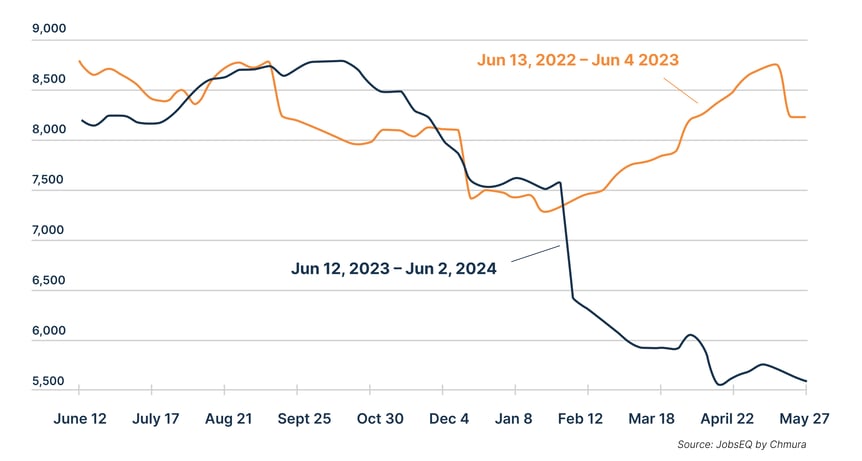On a roll or not? A look at American hot dog consumption

By Henry Switz |
The National Hot Dog and Sausage Council (NHDSC) predicts that Americans will consume over 7 billion hot dogs between Memorial Day and Labor Day, which amounts to almost 50,000 hot dogs per minute. On the single biggest day of consumption in this period, the Fourth of July, Americans are expected to consume over 150 million hot dogs, which is enough to stretch from D.C. to LA five times over.[1]
Most of this consumption will be at home with hot dogs purchased at grocery stores rather than at a national chain. This is because beyond Nathan’s — a restaurant which is significantly smaller than America’s favorite burger joints and is only available in 17 states — there is no nationally recognizable hot dog chain. The most common place you will see a fast-food hot dog is as a secondary item on the menus of chains like Five Guys or Sonic.
Hot dogs as an important cultural motif
According to the Meat Institute’s Chief Strategy Officer and president of NHDSC, Eric Mittenthal, “While hot dogs are a quintessential American food, hot dogs gained popularity around the country in a very regional way. You see it reflected in the varying styles of hot dogs depending on where you are. A New York hot dog, Chicago hot dog, Michigan hot dog, or southern hot dog are all a bit different.”
While New York hot dogs are served topped with brown mustard, sauerkraut, and sweet onion relish, Chicago dogs are all-beef hot dogs topped with yellow mustard, pickle relish, chopped onions, tomato wedges, a pickle spear, two sport peppers, and celery salt to finish. Southern-style hot dogs feature yellow mustard, baked beans or chili, and slaw on top.
In addition to the regional variation, there may be some resilient hometown hot dog operations. “Local communities had their own favorite hot dog stands, many of which have endured to this day,” says Mittenthal, “so it’s hard for a national chain to compete with those local favorites.” Finally, as the cost of dining out rises and Americans face tighter budgets, “hot dogs are also very simple… you can get them at the store and make them at home very quickly and easily."

Rising costs of cookouts
This year’s cookouts will be more costly than ever. The average price of a cookout increased 10% since Memorial Day last year to a conservative estimate of at least $30.[2] One of the main contributors to this inflation is the 7.1% increase in hot dog prices and 6% increase in ground beef prices since April 2023. Both staples of a classic American barbecue, it is hard to imagine many Americans will skimp on hot dogs and burgers despite the inflated prices—budget cuts may come from other dishes or from cooking at home instead of dining out.
And no cookout meal is complete without some condiments and refreshments, both of which have seen recent price hikes as well. Looking at prices on Amazon/Whole Foods, the price of ketchup rose 10% from the second quarter of 2023 to the second quarter of 2024, with Pepsi (+7%), 7Up (+7%), relish (+7%), hot dog buns (+3%), and mustard (+2%) all increasing in cost over the same period.[3] Interestingly, not all product prices are up—the price of Coca Cola has declined 1%, while beer prices are virtually unchanged (0%).
Overall, Americans spent over $8 billion on hot dogs during peak season in 2023, and we can expect this number to be even higher this year. Despite rising costs, 87% of American consumers plan to celebrate Independence day.[4]
What may the future hold for hot dog production? The meat manufacturing industry has seen negative employment growth over the past five years— employment for butchers and other meat, poultry, and fish processing workers has decreased 0.5% annually since 2019. Online job ads are an indicator of likely near-term hiring, and the number of active job ads dropped from 8,723 to 5,715 over the year ending May 13, 2024 (34% decrease), according to JobsEQ.
Active meat manufacturing job ads by date

Changes in yearly hot dog trends could be attributed to industry automation
Why are there such drastically different trends in job ads in 2024 compared to 2023? Increased usage of automation in the industry is a possibility, given the nature of the industry and the minimal education requirements in most job postings. We asked Mittenthal if automation poses a threat to workers in the meat manufacturing industry: “We don’t believe automation is a threat in our industry and would likely be beneficial. Workers are already in high demand with jobs tough to fill. There will likely always be jobs in the industry that automation will not be able to do. Automation would offer the opportunity to improve worker safety for certain roles and allow for more specialization amongst workers that could help build skills and advance careers.”
This positive outlook coupled with the latest data indicate that while automation may be taking a small number of jobs, it is also making existing jobs safer and more stable. Job ads are down across the board, and the industry may just be experiencing a similar hiring slowdown.
Hot dogs are an important part of summer celebrations for many Americans. While you may not want to look too closely at how they’re made, a peek into the labor data shows some interesting trends. Job ads are down so far this year, but consumer demand remains strong — boosted by local traditions, toppings, and culture.
[1] National Hot Dog and Sausage Council, https//www.hor-dog.org/media/consumption-stats
[2] “Kiernan, John, Memorial Day Facts (2024), May 20, 2024, https://wallethub.com/blog/memorial-day-facts/21363
[3] Pattern, Fourth of July Party Prices in 2024, https://pattern.com/blog/fourth-of-july-party-prices-in-2024
[4] National Research Federation, Independence Day, https://nrf.com/research-insights/holiday-data-and-trends/independence-day
Subscribe to the Weekly Economic Update
Subscribe to the Weekly Economic Update and get news delivered straight to your inbox.











